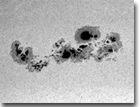 |

|
 |
 Evacuation
Flight Lands Safely at South Pole and Rothera Evacuation
Flight Lands Safely at South Pole and Rothera
A twin-engine airplane made a historic flight to the National
Science Foundation's Amundsen-Scott South Pole Station on April
24 to evacuate Dr. Ronald Shemenski from the station and to replace
him with another physician, Dr. Betty Carlisle. The following day,
the plane safely completed the 1,300-mile return trip to Rothera,
a British Antarctic Survey (BAS) station, en route to its destination
in Chile. NSF, which runs the U.S. Antarctic Program, coordinated
the evacuation. More...
(posted April 25, 2001)
|
 |
|
 NSF
Requests $4.47 Billion for Fiscal 2002 NSF
Requests $4.47 Billion for Fiscal 2002
The National Science Foundation (NSF) announced today a $4.47 billion
budget request for fiscal 2002 -- $56 million (1.3 percent) over
2001. The request highlights a math and science education partnership,
interdisciplinary mathematics research and increased financial support
for graduate students. It also provides increased funding for four
multidisciplinary priority areas: biocomplexity in the environment,
nanoscale science and engineering, information technology research,
and learning for the 21st century. More...
(posted April 9, 2001)
|
 |
|
 Rank
of U.S. Eighth Graders Internationally Is a Mixed Bag, Report Shows
Rank
of U.S. Eighth Graders Internationally Is a Mixed Bag, Report Shows
The United States is producing some of the world's highest-achieving
eighth graders in math and science, yet many students, especially
in urban districts, are performing well below average internationally,
according to a study released on April 4. The Third International
Mathematics and Science Study-Repeat (TIMSS-R) Benchmarking Report
ranked the performance of middle school students from 27 U.S. jurisdictions
(13 states and 14 districts and consortia) against one another and
37 other participating countries. More...
(posted April 4, 2001)
|
 |
|
 Images
Available: Largest Sunspot in Recent Years Images
Available: Largest Sunspot in Recent Years
Dramatic images of the largest sunspot to appear in a decade are
available from the National Science Foundation's (NSF) National
Solar Observatory. More...
(posted April 2, 2001)
|
 |
|
 Antarctic Neutrino Detector Works!
Antarctic Neutrino Detector Works!
An observatory embedded in the Antarctic ice has become the first
in the world to detect high-energy neutrinos -- subatomic particles
created by cataclysmic collisions. The Antarctic Muon and Neutrino
Array (AMANDA) is one of the world's largest particle detectors,
with 677 photodetectors buried deep within the ice beneath the South
Pole. The March 22 issue of Nature reported the array's capability,
as recently proven by its detection of high-energy neutrinos generated
in the earth's atmosphere by cosmic rays striking the earth from
space. More...
(posted Mar 27, 2001)
|
 |
|
 Underground Infrastructure Vulnerable to Quakes
Underground Infrastructure Vulnerable to Quakes
The vast network of subterranean pipelines and cables that sustain
our daily utility services are among the most vulnerable infrastructures
to earthquakes, according to experts at the NSF-funded Multidisciplinary
Center for Earthquake Engineering Research at the University of
Buffalo. In the recent Nisqually earthquake near Seattle, a hypocenter
closer to the surface also would have resulted in extensive damage.
More...
(posted Mar 21, 2001)
|


|

